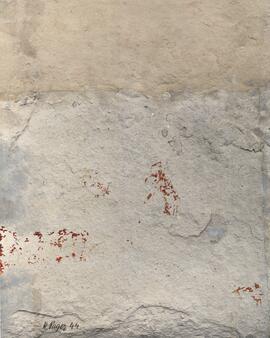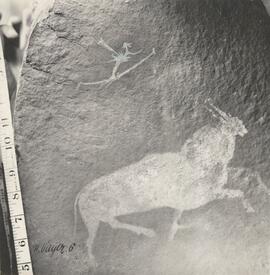HPC HPC-RARI-HPC-01-62HC.jpg
·
Item
Part of Pager, Harald
P43 pager F187 - 188.
Apart from the beautiful polychrome eland, in almost every conceivable attitude, including frontal and back views, this panel includes a number of particularly interesting individual items.
For example:
1. Low down at the left hand side, a series of concentric semi-circles that represents honeycombs. Honeycombs take up this form when not confined to a hive or hole in a rock. The honey was particularly significant to the Bushmen, both as a source of sweetness and the basis for an alcoholic drink.
2. Several 'flying creatures' or alites as Harald Pager named them. There is a very unusual example near the top of the panel. These may represent the spirits of dead Bushmen/eland/medicine-men who have achieved a state of trance and whose spirits have temporarily left their bodies.
3. Two large 'bristle bulls' as named by Harald Pager, facing each other, head to head, low down to right centre of the panel. Harald Pager considered these to be mythological creatures but it is also possible to interpret them as two old bull eland confronting each other.
4. A baboon-like creature of mythological significance, low down in the centre of the panel. Such a creature is dealt with in the folklore of the Bushmen as recorded by Dr. W.H.I. Bleek.
A detailed analysis of every item in the paintings is contained in Harald Pager's book 'Ndedema'.
Many of the concepts of the Bushmen are also dealt with in the book 'Rock Art of Southern Africa' by H.C. Woodhouse, the compiler of this catalogue. Botha’s Shelter I











